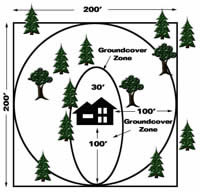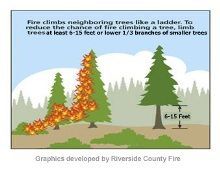Living with Fire – Fire Safe Zones
Creating Defensible Space
 Creating permanent defensible space is a progressive strategy that may take a few years. Each year, steadily remove the overgrown, fire hazardous plants and replace them with fire resistant, well distributed plants. As you begin growing firesafe view screens, for example, you might wait until you have an effective screen before completely removing some of the hazardous plants that currently provide privacy.
Creating permanent defensible space is a progressive strategy that may take a few years. Each year, steadily remove the overgrown, fire hazardous plants and replace them with fire resistant, well distributed plants. As you begin growing firesafe view screens, for example, you might wait until you have an effective screen before completely removing some of the hazardous plants that currently provide privacy.
Create a Plan
When planning a firesafe landscape, start with a sketch of your property as it currently looks, noting hazardous areas, overhead power line location, irrigation, areas you would like to preserve, and other considerations you have. Thinking in terms of defensible space, sketch concentric rings (like a bulls eye) at 50, 100, and 200 feet from your home. Note which types of vegetation fall within those zones and begin removing, reducing and replacing vegetation within the first ring. Because water is available at the house, consider replacing fire hazardous species with irrigated plants inside the first ring. Healthy, well watered plants will resist combustion better than dry plants. As you progress in to the spaces beyond 50 feet, rely less on irrigation and concentrate more on the spatial distribution and plant species of the vegetation.
Fireproof Plant Myth
The concept of “fireproof” plants is a myth. All plants will burn given the right conditions. Referring to a plant as “firesafe” means that it tends not be a significant fuel source by itself. Certain plants may be a poor fuel source because they don’t contain a lot of woody material, or they tend to grow in low densities, or their chemical composition actually resists heat and combustion.
Spacing
Besides those specific characteristics, one must also consider two other factors: the distribution and the maintenance of the plants. A good example is manzanita. While most people cringe at the thought of a fire ripping through a manzanita thicket, a well watered individual not in a dense stand is actually fire resistant. The key is to keep a wide space between individual plants and to regularly remove the dead material that accumulates on it. A healthy, green manzanita, with five to six feet of clearance around it and no dead branches is very likely to survive a low to moderate intensity fire. Some low growing species of manzanita are recommended because of their drought tolerance and fire resistance.
Vertical Fuel Ladders
 The vertical fuel ladders and horizontal fuel paths must be removed, but as you replant your landscape you can also ensure that these conditions are not likely to develop. You can also improve your site by varying plants sizes and growth characteristics to discourage continuous paths of vegetation. One strategy is to plant your highest growing and lowest growing plants next to each other, ensuring that they won’t grow together and create a hazard. For example, if you have a nice cedar close to your home, trim the branches to height of at least 8 feet, and plant irrigated ground cover around the tree’s perimeter. This accomplishes a couple of objectives in one simple act.
The vertical fuel ladders and horizontal fuel paths must be removed, but as you replant your landscape you can also ensure that these conditions are not likely to develop. You can also improve your site by varying plants sizes and growth characteristics to discourage continuous paths of vegetation. One strategy is to plant your highest growing and lowest growing plants next to each other, ensuring that they won’t grow together and create a hazard. For example, if you have a nice cedar close to your home, trim the branches to height of at least 8 feet, and plant irrigated ground cover around the tree’s perimeter. This accomplishes a couple of objectives in one simple act.
Fire Safe Planting
The Resource Conservation Districts, University of California Cooperative Extension, US Forest Service and California Department of Forestry and Fire Protection all have firesafe plant lists specific to the area. Research the plants that you like to determine their suitability for your site and your needs. Find out how much water they need, how big they grow, what maintenance they require, and what other values they provide. Some firesafe plants will make good view screens while others may stay low, helping you prevent the growth of fuel ladders. In any case, take some time to plan, consider your numerous options, and use common sense in creating defensible space.
Events
Calaveras Big Trees State Park | 12:00 pm - 3:00 pm
Holiday Light Show
Crystal Falls | 5:00 pm - 9:30 pm
Christmas Tree Lot
Christmas Tree Lot | 3:00 pm - 7:00 pm
Manzanita Building, Motherlode Fairgrounds | 12:00 pm - 5:00 pm
Christmas Eve Service
Sonora United Methodist Church, Sonora CA | 2:00 pm - 3:00 pm
St. Matthew Lutheran Christmas Eve Service
St. Matthew Lutheran Church | 5:00 pm - 6:00 pm
St Matthew Lutheran Church | 10:00 am
Community Christmas day dinner
Manzanita Building, Motherlode Fairgrounds | 12:00 pm - 3:00 pm
Murphys Friends Free Christmas Dinner
Native Sons Hall | 1:00 pm - 3:00 pm
Tuolumne County Enrichment Center | 11:00 am - 2:00 pm
Warming Hut
Calaveras Big Trees State Park | 12:00 pm - 3:00 pm
Holiday Light Show
Crystal Falls | 5:00 pm - 9:30 pm
Calaveras Big Trees State Park | 12:00 pm - 3:00 pm
Christmas Light Show
Christmas light show | 6:00 pm - 9:00 pm
